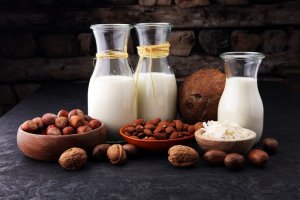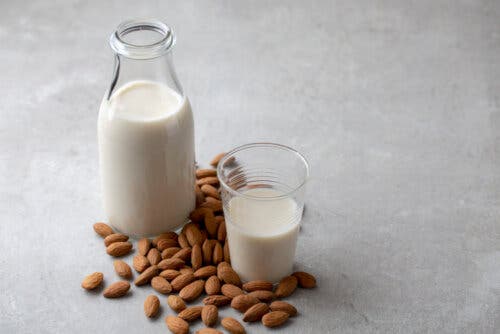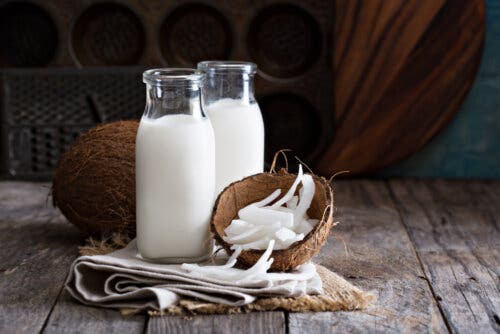Plant-based Drinks for Babies and Children

Currently, you can find a wide variety of plant-based drinks on the market. These drinks are a great way to add variety to your diet or to carry out a vegan lifestyle. What’s more, for those who are allergic to milk protein, plant-based drinks are an excellent alternative.
Are plant-based drinks comparable to cow’s milk?
Nutritionally, we can’t consider plant-based drinks to be a substitute for cow’s milk. Depending on the vegetable source, their composition is very variable. However, at the same time, it’s also important to mention that there’s no need to replace milk, as it’s not essential to our diets.
Milk is rich in calcium, proteins, and fat – although the last two depend on the version of milk you drink. In this sense, when it comes to plant-based drinks, the predominant macronutrient varies depending on their source.
Those that come from cereals or pseudo-cereals, like rice-based or oatmeal-based drinks, are rich in carbohydrates. Others, which are obtained from legumes, are rich in proteins. Then, there is a third group that comes from fatty fruits or dry nuts, like coconut or almond-based drinks, which stand out for their high fat content.
So, when we consider nutritional composition, the vegan drink that’s most similar to cow’s milk is soy milk enriched with calcium. This is thanks to the fact that its protein, fat, and calcium content are close to that of milk.
Plant-based milk for newborns
During a child’s first 6 months of life, breastmilk and/or formula are a newborn’s main source of nourishment. While the World Health Organization recommends that babies get their nutrition exclusively from their mothers’ breastmilk, that doesn’t always happen.

Mastitis – an inflammation of the mammary glands – is very normal and can cause some women to cease breastfeeding. This is just one example of reasons why a mother may bottle-feed her little one. But, what if she’s a vegan? What formula should vegan mothers give their newborns to substitute breastmilk?
Another possibility, which is more common than you may think, is that a child has a cow’s milk protein allergy (CMPA). In fact, studies suggest that between 2 and 3% of babies suffer from this allergy. So, what’s the protocol for non-breastfeeding babies who can’t drink cow’s milk due to an allergy
The vegan approach
A vegan diet in children is perfectly compatible with proper growth according to the main scientific associations. However, parents need to be well-educated on the issue and apply the vegan approach carefully. There are many reasons why parents may be for or against this type of lifestyle. However, in either case, it’s important to respect their decision.
A vegan diet doesn’t include any food that comes from an animal source and, therefore, excludes all traditional milk. For those families that opt to supplement breastmilk, there are soy and rice formulas that are suitable for vegan babies. Soy milk needs to be free of isoflavones if they’re meant for babies that are under the age of 6 months. And, as for rice milk, they should be hydrolyzed in order to minimize their arsenic content.
After the age of 6 months, babies can consume soy milk with isoflavones. Later, after they reach the age of 2 years, parents can incorporate other plant-based drinks in their little one’s diet.
However, it’s important to point out once again that parents need to carefully plan their child’s vegan diet. A dietitian or nutritionist with knowledge of the subject should oversee what babies eat and drink
Cow’s Milk Protein Allergy (CMPA)
When babies are allergic to the protein in cow’s milk, the only treatment is to completely avoid all products containing cow’s milk. In newborns, parents can approach the issue in one of 2 ways, depending on how they feed their babies.
In the case of babies that breastfeed, then the one who needs to avoid dairy is the mother. Mothers will need to eliminate all dairy products from their diet and control their calcium and vitamin D levels. To find out how much calcium and vitamin D they need, it helps to know how much of these micronutrients they consumed previously.
Once they know their individual calcium demands, they can increase their intake of calcium-rich foods. Of course, it’s important to remember that a woman’s calcium demands are higher while breastfeeding.
In babies that drink formula, there are several possibilities. Hydrolyzed milk is the treatment of choice in these cases. And for those babies that don’t tolerate it, there are soy and rice-based milks which meet the specifications we mentioned above.

From the time children are two years old, parents can substitute these formulas with enriched plant-based milks. In these cases, it’s important to evaluate the protein content in a child’s diet to make sure their requirements are covered.
How to make the right decision when choosing plant-based drinks
To choose between so many options, parents need to look at the nutritional label. While there isn’t a lot of variation among different brands of cow’s milk, there is a lot of variety when it comes to plant-based drinks. Therefore, keep the following in mind when making your choice:
- The amount of raw material the milk contains, which will appear in the form of a percentage.
- Other specifications related to the rest of the ingredients:
- Check whether the source is enriched in micronutrients or not. Calcium and vitamin D are two of the most common supplements, given that they’re present naturally in cow’s milk.
- The amount of added sugar, which should be no higher than 4 to 5 grams per 100 grams of milk.
- Make sure manufacturers haven’t taken measures to cheapen the product, such as incorporating mixes of raw material. For example, some coconut-based drinks have a high rice content.
- To reach the same fat content as milk, vegetable oils may be added. If they’re added in a small quantity, it’s irrelevant and doesn’t decrease the quality of the diet.
Currently, you can find a wide variety of plant-based drinks on the market. These drinks are a great way to add variety to your diet or to carry out a vegan lifestyle. What’s more, for those who are allergic to milk protein, plant-based drinks are an excellent alternative.
Are plant-based drinks comparable to cow’s milk?
Nutritionally, we can’t consider plant-based drinks to be a substitute for cow’s milk. Depending on the vegetable source, their composition is very variable. However, at the same time, it’s also important to mention that there’s no need to replace milk, as it’s not essential to our diets.
Milk is rich in calcium, proteins, and fat – although the last two depend on the version of milk you drink. In this sense, when it comes to plant-based drinks, the predominant macronutrient varies depending on their source.
Those that come from cereals or pseudo-cereals, like rice-based or oatmeal-based drinks, are rich in carbohydrates. Others, which are obtained from legumes, are rich in proteins. Then, there is a third group that comes from fatty fruits or dry nuts, like coconut or almond-based drinks, which stand out for their high fat content.
So, when we consider nutritional composition, the vegan drink that’s most similar to cow’s milk is soy milk enriched with calcium. This is thanks to the fact that its protein, fat, and calcium content are close to that of milk.
Plant-based milk for newborns
During a child’s first 6 months of life, breastmilk and/or formula are a newborn’s main source of nourishment. While the World Health Organization recommends that babies get their nutrition exclusively from their mothers’ breastmilk, that doesn’t always happen.

Mastitis – an inflammation of the mammary glands – is very normal and can cause some women to cease breastfeeding. This is just one example of reasons why a mother may bottle-feed her little one. But, what if she’s a vegan? What formula should vegan mothers give their newborns to substitute breastmilk?
Another possibility, which is more common than you may think, is that a child has a cow’s milk protein allergy (CMPA). In fact, studies suggest that between 2 and 3% of babies suffer from this allergy. So, what’s the protocol for non-breastfeeding babies who can’t drink cow’s milk due to an allergy
The vegan approach
A vegan diet in children is perfectly compatible with proper growth according to the main scientific associations. However, parents need to be well-educated on the issue and apply the vegan approach carefully. There are many reasons why parents may be for or against this type of lifestyle. However, in either case, it’s important to respect their decision.
A vegan diet doesn’t include any food that comes from an animal source and, therefore, excludes all traditional milk. For those families that opt to supplement breastmilk, there are soy and rice formulas that are suitable for vegan babies. Soy milk needs to be free of isoflavones if they’re meant for babies that are under the age of 6 months. And, as for rice milk, they should be hydrolyzed in order to minimize their arsenic content.
After the age of 6 months, babies can consume soy milk with isoflavones. Later, after they reach the age of 2 years, parents can incorporate other plant-based drinks in their little one’s diet.
However, it’s important to point out once again that parents need to carefully plan their child’s vegan diet. A dietitian or nutritionist with knowledge of the subject should oversee what babies eat and drink
Cow’s Milk Protein Allergy (CMPA)
When babies are allergic to the protein in cow’s milk, the only treatment is to completely avoid all products containing cow’s milk. In newborns, parents can approach the issue in one of 2 ways, depending on how they feed their babies.
In the case of babies that breastfeed, then the one who needs to avoid dairy is the mother. Mothers will need to eliminate all dairy products from their diet and control their calcium and vitamin D levels. To find out how much calcium and vitamin D they need, it helps to know how much of these micronutrients they consumed previously.
Once they know their individual calcium demands, they can increase their intake of calcium-rich foods. Of course, it’s important to remember that a woman’s calcium demands are higher while breastfeeding.
In babies that drink formula, there are several possibilities. Hydrolyzed milk is the treatment of choice in these cases. And for those babies that don’t tolerate it, there are soy and rice-based milks which meet the specifications we mentioned above.

From the time children are two years old, parents can substitute these formulas with enriched plant-based milks. In these cases, it’s important to evaluate the protein content in a child’s diet to make sure their requirements are covered.
How to make the right decision when choosing plant-based drinks
To choose between so many options, parents need to look at the nutritional label. While there isn’t a lot of variation among different brands of cow’s milk, there is a lot of variety when it comes to plant-based drinks. Therefore, keep the following in mind when making your choice:
- The amount of raw material the milk contains, which will appear in the form of a percentage.
- Other specifications related to the rest of the ingredients:
- Check whether the source is enriched in micronutrients or not. Calcium and vitamin D are two of the most common supplements, given that they’re present naturally in cow’s milk.
- The amount of added sugar, which should be no higher than 4 to 5 grams per 100 grams of milk.
- Make sure manufacturers haven’t taken measures to cheapen the product, such as incorporating mixes of raw material. For example, some coconut-based drinks have a high rice content.
- To reach the same fat content as milk, vegetable oils may be added. If they’re added in a small quantity, it’s irrelevant and doesn’t decrease the quality of the diet.
All cited sources were thoroughly reviewed by our team to ensure their quality, reliability, currency, and validity. The bibliography of this article was considered reliable and of academic or scientific accuracy.
- Martínez MB et al. (2003). Incidencia de alergia a proteínas de leche de vaca en el primer año de vida y su repercusión en el consumo de hidrolizados. In Anales de Pediatría (Vol. 58, No. 2, pp. 100-105). Elsevier Doyma.
- Biarge MM. (2017). Niños vegetarianos,¿ niños sanos?. Asociación Española de Pediatría.
- Martín AP. (2013). Alergia a proteínas de leche de vaca. Protocolos diagnósticos y terapéuticos en Pediatría. Protoc diagn ter pediatr, 1, 51-61.
This text is provided for informational purposes only and does not replace consultation with a professional. If in doubt, consult your specialist.








